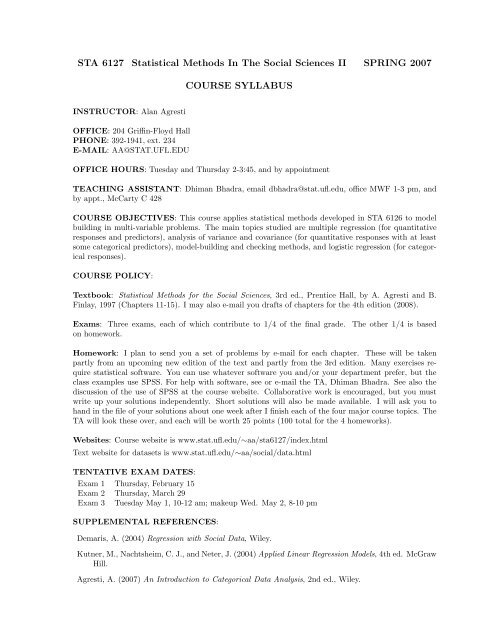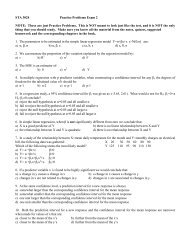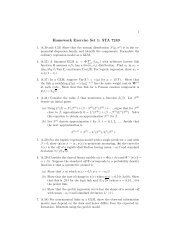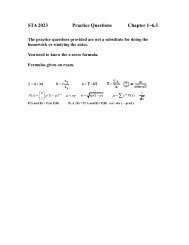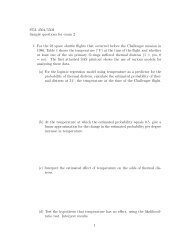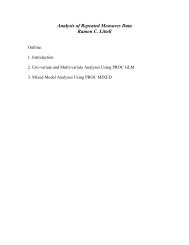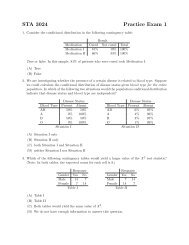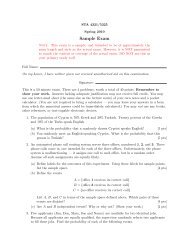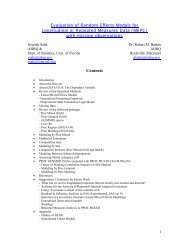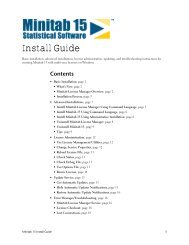Syllabus - Department of Statistics
Syllabus - Department of Statistics
Syllabus - Department of Statistics
Create successful ePaper yourself
Turn your PDF publications into a flip-book with our unique Google optimized e-Paper software.
STA 6127 Statistical Methods In The Social Sciences II SPRING 2007<br />
COURSE SYLLABUS<br />
INSTRUCTOR: Alan Agresti<br />
OFFICE: 204 Griffin-Floyd Hall<br />
PHONE: 392-1941, ext. 234<br />
E-MAIL: AA@STAT.UFL.EDU<br />
OFFICE HOURS: Tuesday and Thursday 2-3:45, and by appointment<br />
TEACHING ASSISTANT: Dhiman Bhadra, email dbhadra@stat.ufl.edu, <strong>of</strong>fice MWF 1-3 pm, and<br />
by appt., McCarty C 428<br />
COURSE OBJECTIVES: This course applies statistical methods developed in STA 6126 to model<br />
building in multi-variable problems. The main topics studied are multiple regression (for quantitative<br />
responses and predictors), analysis <strong>of</strong> variance and covariance (for quantitative responses with at least<br />
some categorical predictors), model-building and checking methods, and logistic regression (for categorical<br />
responses).<br />
COURSE POLICY:<br />
Textbook: Statistical Methods for the Social Sciences, 3rd ed., Prentice Hall, by A. Agresti and B.<br />
Finlay, 1997 (Chapters 11-15). I may also e-mail you drafts <strong>of</strong> chapters for the 4th edition (2008).<br />
Exams: Three exams, each <strong>of</strong> which contribute to 1/4 <strong>of</strong> the final grade.<br />
on homework.<br />
The other 1/4 is based<br />
Homework: I plan to send you a set <strong>of</strong> problems by e-mail for each chapter. These will be taken<br />
partly from an upcoming new edition <strong>of</strong> the text and partly from the 3rd edition. Many exercises require<br />
statistical s<strong>of</strong>tware. You can use whatever s<strong>of</strong>tware you and/or your department prefer, but the<br />
class examples use SPSS. For help with s<strong>of</strong>tware, see or e-mail the TA, Dhiman Bhadra. See also the<br />
discussion <strong>of</strong> the use <strong>of</strong> SPSS at the course website. Collaborative work is encouraged, but you must<br />
write up your solutions independently. Short solutions will also be made available. I will ask you to<br />
hand in the file <strong>of</strong> your solutions about one week after I finish each <strong>of</strong> the four major course topics. The<br />
TA will look these over, and each will be worth 25 points (100 total for the 4 homeworks).<br />
Websites: Course website is www.stat.ufl.edu/∼aa/sta6127/index.html<br />
Text website for datasets is www.stat.ufl.edu/∼aa/social/data.html<br />
TENTATIVE EXAM DATES:<br />
Exam 1 Thursday, February 15<br />
Exam 2 Thursday, March 29<br />
Exam 3 Tuesday May 1, 10-12 am; makeup Wed. May 2, 8-10 pm<br />
SUPPLEMENTAL REFERENCES:<br />
Demaris, A. (2004) Regression with Social Data, Wiley.<br />
Kutner, M., Nachtsheim, C. J., and Neter, J. (2004) Applied Linear Regression Models, 4th ed. McGraw<br />
Hill.<br />
Agresti, A. (2007) An Introduction to Categorical Data Analysis, 2nd ed., Wiley.
OUTLINE OF TOPICS:<br />
1. Multiple Regression Modelling<br />
Multiple regression model<br />
Multiple correlation and R-squared<br />
Inference for multiple regression coefficients<br />
Modeling interaction<br />
Comparing regression models<br />
Partial correlation<br />
Standardized regression coefficients<br />
2. Comparing Groups:<br />
Analysis <strong>of</strong> Variance and Covariance Methods<br />
1-way ANOVA<br />
Multiple comparisons <strong>of</strong> means<br />
ANOVA and dummy variables in regression<br />
2-way ANOVA and regression<br />
Analysis <strong>of</strong> covariance models<br />
Adjusted means<br />
3. Model Building with Multiple Regression<br />
Model selection procedures<br />
Regression diagnostics<br />
Multicollinearity<br />
Generalized linear models<br />
Nonlinearity: Polynomial regression<br />
Nonlinearity: Exponential regression<br />
4. Modeling Categorical Responses:<br />
Logistic Regression<br />
Logistic regression<br />
Inference for logistic regression<br />
Logistic models for ordinal responses<br />
Logistic models for nominal responses


